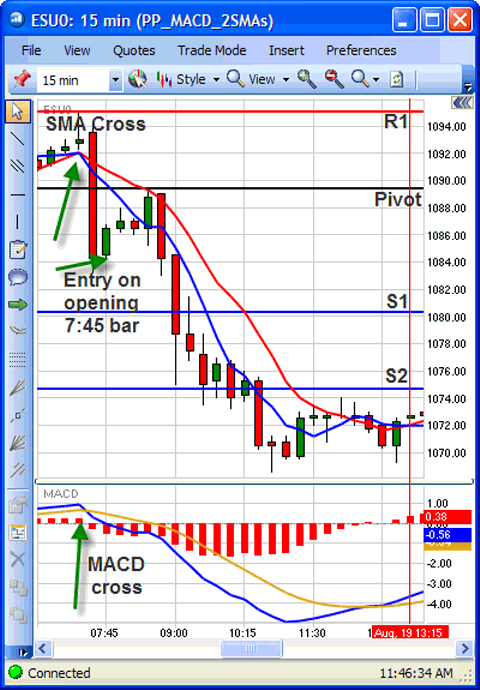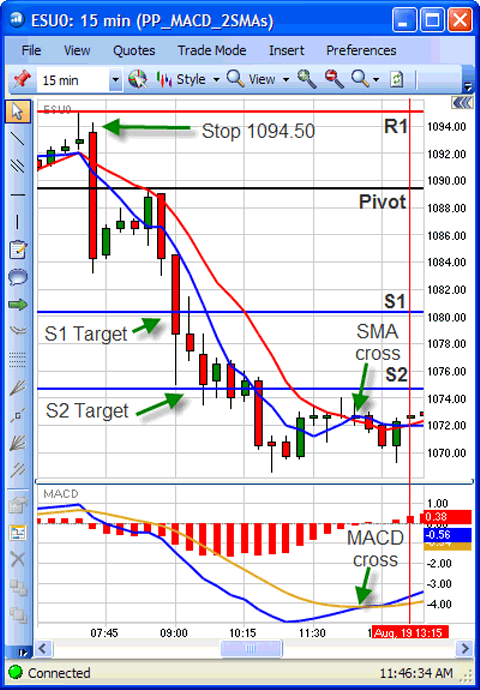In all my years of following the markets, I have found one methodology above all others that is the most effective for my day and swing trading. The Turner Breakout Reversal (TBR) method is designed to quickly scan a given market and determine if a particular market is heading for a breakout or reversal after a market reaches critical support and resistance levels. Along with responsible risk management, any trader can benefit from using support and resistance, with momentum indicators, to trade on higher quality signals.
If you have your charts’ default to the TBR settings, you can quickly go from market to market and see if there is a potential setup forming. I use Pivot Points for support and resistance, the MACD for momentum, and two simple moving averages for trade triggers; all of this is done on a 15 minute chart. Before we dive into the specifics of the methodology, we should go into a little more depth about each indicator so that you have a greater understanding of what we are trying to accomplish.
Pivot Points (PP): Pivot points were created by floor traders to determine critical intraday support and resistance levels. Floor traders at the exchanges were able to use a few simple calculations to generate multiple support and resistance levels for the trading day. Pivot points are known as “predictive” indicators because they forecast levels of resistance and support that market prices have not yet reached. We will use these levels to help determine if the market is in a breakout or a reversal.
Moving Average Convergence/Divergence (MACD): The MACD is a momentum indicator using moving averages and an oscillator to create a trend following indicator. By nature, the MACD is a “lagging” indicator, as all momentum indicators are. The MACD cannot tell you when you are at the bottom or at the top of a market, but it can tell you when you are in the midst of a forming or failing trend. The best thing the MACD provides is its ability to show how strong the momentum is during a market rally or decline.
Simple Moving Averages (SMA): Simple moving averages calculate the average price of a market over a specific number of time periods. For the TBR system we use a fast simple moving average and a slow simple moving average to measure momentum in the market and use as a trading trigger. Accordingly, by using the two SMAs as triggers we have a second momentum indicator that we can use to confirm a trading signal.
Putting it all together:
By using pivot points, we are able to determine daily support and resistance levels. We use the MACD to measure the momentum of the move and the two simple moving averages as trade triggers. For breakouts, we are looking for markets that break through support/resistance, have strong MACD momentum in our favor, and the fast SMA intersecting the slow SMA. For reversals, we look for the market to fail to break out at support/resistance, the MACD momentum to weaken, and the SMAs to reverse.
Ground Rules:
- Set your charts to use Pivot Points, Candlesticks, the standard MACD, a 5 period SMA, and a 10 period SMA.
- For the examples below we will be using a 15 minute chart. For traders new to TBR, I suggest starting with a 15 minute chart since that is what we are using in the examples. However, you can use 5 minute, 10, 30, 1 hour charts, etc. Each trader is different and will find a time frame they are comfortable with just like how all traders will find a methodology they are most comfortable with. In my experience, the shorter the time frame the weaker the signals. Some day-traders want to use tick charts, but these charts are most likely daily noise. You need the charts to have intervals long enough to develop quality patterns. Shorter time frames will create more signals but they will be lower quality signals. However, if the time frame is too long traders might miss out on a move. If the time frame is too short traders may be whipsawed in and out of the market.
- Only take a trade when all three signals line up. There is a pivot point signal, a MACD signal and the SMA signal. All three must “turn their keys” to execute a trade. We only want to trade the higher quality signals.
- Don’t fret about jumping in early or worry about missing too much of a move. If you try to jump in ahead of a signal you will, more often than not, be whipsawed out of the market. It is better to be patient and catch a portion of a price move than it is to jump in early hoping the trade has already begun in a choppy market.
- Don’t trade because you are getting bored! Too many times a trader watches the markets, sees one or two signals line up, and instead of waiting for the third line they jump in because they got tired of watching the market. If you cannot discipline yourself to follow the methodology (and this goes for any methodology or system) you might be better off having your broker execute it for you.
- Keep an eye on the fundamental economic calendar. Fundamentals rule the markets. When fundamental news comes out it can wipe away all the technical patterns. Make sure you are aware when the Fed is speaking if you are trading the S&P or when the Energy Numbers come out when trading Crude Oil.
Now that we have some ground rules lets get to the Turner Breakout Reversal (TBR) Trading Methodology.
There are 4 types of strategies:
- Bull Market Breakout: Long on a breakout through resistance. During a bull market we want to get long on a breakout and ride the wave to the next resistance level (and beyond if we are lucky). For example, if there is a bull market on Gold we want to buy on the next breakout through resistance.
- Bear or Sideways Market Reversal: Short on a failed breakout attempt at resistance. In a bear market, or a sideways market, there is going to be a lot of selling pressure at key resistance levels. In these markets we want to sell strength. If the US Dollar is trading in a channel or in a bear market, we want to sell USD when it rallies and then fails at a resistance level.
- Bear Market Breakout: Short on a breakout through support. In a bear market we want to get short on a breakout and ride the wave down to the next support level. When the S&P was in a tailspin last year we would want to short as we broke though through support levels.
- Bull or Sideways Market Reversal: Long on a failed breakout attempt at support. In a bull or sideways market we want to buy on a failed breakout attempt through support. Gold tends to rise and then consolidate. When the market gets to the support level we want to “buy the dip” and sell it at the next resistance area.
In my experience the highest quality of trade signals correspond with the longer-term trend. Let us say, for example, that the market we are looking at has been on a multi-month uptrend. We would rather take signals that are getting long on a breakout through resistance or long on a failed bearish breakout attempt at support. Shorting in a bull market is counter trading, and I have found this method to entail lower percentage trades. Leave counter trading to the experts and take the higher quality signals TBR provides.
Example: August 19th, 2010
Any trades are educational examples only. They do not include commissions and fees.
What occured on August 19th, 2010, is a great example of a bear market breakout. Many people had been bearish on the Stock Market and we had been waiting for a signal to get short. We got a very good one on this day.
Below is a 15 minute chart for the September 2010 Emini S&P 500. R1 is 1095.00, PP is 1089.50, S1 is 1080.50 and S2 is 1074.75. We have a 5 period SMA and a 10 period SMA with a standard MACD.
At the close of the 7:30 AM candle, the 5 SMA had crossed the 10 SMA, the MACD had turned bearish, and the candle had closed below the pivot point. At the close of this bar is our signal to get short. We were short at the open of the 7:45 bar, which is 1084.50. It is important to note we waited for all three indicators to line up. The SMAs crossed before the MACD, and the last signal to occur was the close of the 7:30 AM bar below the Pivot Point.
Emini S&P 500 Chart 1
Now that we are in the market, we need a stop and profit objective. The stop will be right above the candlestick that gave us the short signal. The high of the 7:30 AM bar is 1094.25. We will make the stop at 1094.50, which makes the risk 10 points (short from 1094.50), or $500.
Depending on how conservative or aggressive your trading is, you have a few options on the profit target. The first profit target is S1 (Support 1) at 1080.50, which is a $200 target. The second profit target is S2 (Support 2) at 1074.75, which is a $487.50 target. The other way to exit is to get out when the MACD and SMAs turn bullish. This happens at the 12:30 PM bar at 1072.50. You should always exit if the MACD and SMAs reverse. If we waited for this, the exit would be at 1072.50, for $600 per lot.
Emini S&P 500 Chart 2
Any trades are educational examples only. They do not include commissions and fees.
Variations of Turner Breakout Reversal (TBR)
Multiple lots: Traders using multiple lots can use S1, S2 and the SMA/MACD cross as multiple profit targets.
Pyramiding: As the market breaks through new levels, some traders will add on to their positions by taking advantage of major moves in the market.
Time Frames: Some traders like to use 5 and 10 minute charts for more trades and lower risk/reward. Some traders like using day charts for swing trading. The beauty of the TBR methodology is you can use it for the time frame that you are most comfortable with.


